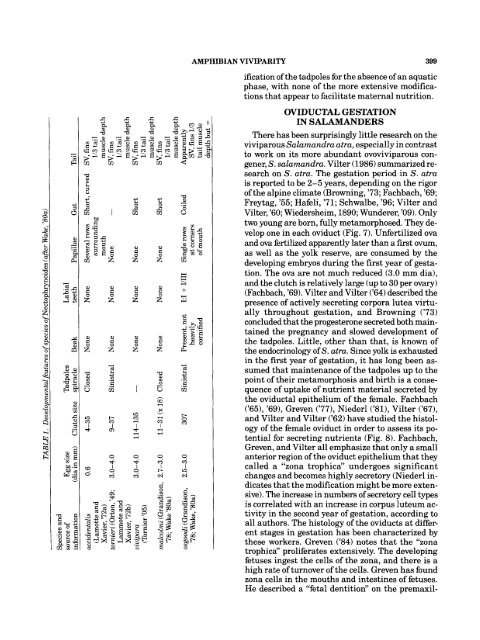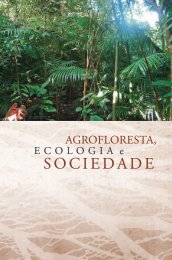Evolution of Oviductal Gestation in Amphibians
Evolution of Oviductal Gestation in Amphibians
Evolution of Oviductal Gestation in Amphibians
You also want an ePaper? Increase the reach of your titles
YUMPU automatically turns print PDFs into web optimized ePapers that Google loves.
W<br />
W<br />
z<br />
2<br />
3<br />
U<br />
.3<br />
d<br />
iij<br />
c-<br />
m<br />
I<br />
Q,<br />
4 I<br />
R<br />
.^<br />
2<br />
U<br />
k<br />
c<br />
m<br />
W<br />
z<br />
z<br />
W<br />
W<br />
$<br />
2<br />
G<br />
0<br />
h<br />
W<br />
rl<br />
x<br />
v<br />
rl<br />
m<br />
I<br />
rl<br />
rl<br />
R I<br />
?<br />
m<br />
AMPHIBIAN VIVIPARITY 399<br />
ification <strong>of</strong> the tadpoles for the absence <strong>of</strong> an aquatic<br />
phase, with none <strong>of</strong> the more extensive modifica-<br />
tions that appear to facilitate maternal nutrition.<br />
OVIDUCTAL GESTATION<br />
IN SALAMANDERS<br />
There has been surpris<strong>in</strong>gly little research on the<br />
viviparous Salamandra atra, especially <strong>in</strong> contrast<br />
to work on its more abundant ovoviviparous congener,<br />
s. salamandra. Vilter (1986) summarized research<br />
on S. atra. The gestation period <strong>in</strong> S. atra<br />
is reported to be 2-5 years, depend<strong>in</strong>g on the rigor<br />
<strong>of</strong> the alp<strong>in</strong>e climate (Brown<strong>in</strong>g, '73; Fachbach, '69;<br />
Freytag, '55; Hafeli, '71; Schwalbe, '96; Vilter and<br />
Vilter, '60; Wiedersheim, 1890; Wunderer, '09). Only<br />
two young are born, fully metamorphosed. They develop<br />
one <strong>in</strong> each oviduct (Fig. 7). Unfertilized ova<br />
and ova fertilized apparently later than a first ovum,<br />
as well as the yolk reserve, are consumed by the<br />
develop<strong>in</strong>g embryos dur<strong>in</strong>g the first year <strong>of</strong> gestation.<br />
The ova are not much reduced (3.0 mm dia),<br />
and the clutch is relatively large (up to 30 per ovary)<br />
(Fachbach, '69). Vilter and Vilter ('64) described the<br />
presence <strong>of</strong> actively secret<strong>in</strong>g corpora lutea virtually<br />
throughout gestation, and Brown<strong>in</strong>g ('73)<br />
concluded that the progesterone secreted both ma<strong>in</strong>ta<strong>in</strong>ed<br />
the pregnancy and slowed development <strong>of</strong><br />
the tadpoles. Little, other than that, is known <strong>of</strong><br />
the endocr<strong>in</strong>ology <strong>of</strong> S. atru. S<strong>in</strong>ce yolk is exhausted<br />
<strong>in</strong> the first year <strong>of</strong> gestation, it has long been assumed<br />
that ma<strong>in</strong>tenance <strong>of</strong> the tadpoles up to the<br />
po<strong>in</strong>t <strong>of</strong> their metamorphosis and birth is a consequence<br />
<strong>of</strong> uptake <strong>of</strong> nutrient material secreted by<br />
the oviductal epithelium <strong>of</strong> the female. Fachbach<br />
('65), '691, Greven ('77), Niederl ('81), Vilter ('67),<br />
and Vilter and Vilter ('62) have studied the histology<br />
<strong>of</strong> the female oviduct <strong>in</strong> order to assess its potential<br />
for secret<strong>in</strong>g nutrients (Fig. 8). Fachbach,<br />
Greven, and Vilter all emphasize that only a small<br />
anterior region <strong>of</strong> the oviduct epithelium that they<br />
called a "zona trophica" undergoes significant<br />
changes and becomes highly secretory (Niederl <strong>in</strong>dicates<br />
that the modification might be more extensive).<br />
The <strong>in</strong>crease <strong>in</strong> numbers <strong>of</strong> secretory cell types<br />
is correlated with an <strong>in</strong>crease <strong>in</strong> corpus luteum activity<br />
<strong>in</strong> the second year <strong>of</strong> gestation, accord<strong>in</strong>g to<br />
all authors. The histology <strong>of</strong> the oviducts at different<br />
stages <strong>in</strong> gestation has been characterized by<br />
these workers. Greven ('84) notes that the "zona<br />
trophica" proliferates extensively. The develop<strong>in</strong>g<br />
fetuses <strong>in</strong>gest the cells <strong>of</strong> the zona, and there is a<br />
high rate <strong>of</strong> turnover <strong>of</strong> the cells. Greven has found<br />
zona cells <strong>in</strong> the mouths and <strong>in</strong>test<strong>in</strong>es <strong>of</strong> fetuses.<br />
He described a "fetal dentition" on the premaxil-






